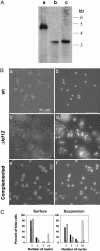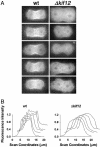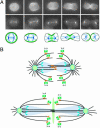A mitotic kinesin-like protein required for normal karyokinesis, myosin localization to the furrow, and cytokinesis in Dictyostelium
- PMID: 15546981
- PMCID: PMC528903
- DOI: 10.1073/pnas.0407304101
A mitotic kinesin-like protein required for normal karyokinesis, myosin localization to the furrow, and cytokinesis in Dictyostelium
Abstract
Dictyostelium mitotic kinesin Kif12 is required for cytokinesis. Myosin II localization to the cleavage furrow is severely depressed in Kif12-null (Deltakif12) cells, which accounts in part for the cytokinesis failure. Myosin II-null cells, however, undergo mitosis-coupled cytokinesis when adhering to a surface, whereas the Deltakif12 cells cannot. During mitosis, the rate of change of internuclear separation in Deltakif12 cells is reduced compared with wild-type cells, indicating multiple roles of this molecular motor during mitosis and cytokinesis. GFP-Kif12, which rescues wild-type behavior when expressed in the Deltakif12 strain, is concentrated in the nucleus in interphase cells, translocates to the cytoplasm at the onset of mitosis, appears in the centrosomes and spindle, and later is concentrated in the spindle midbody. Given these results, we hypothesize a mechanism for myosin II translocation to the furrow to set up the contractile ring.
Figures





References
-
- Rappaport, R. (1961) J. Exp. Zool. 148, 81–89. - PubMed
-
- Rappaport, R. (1996) Cytokinesis in Animal Cells (Cambridge Univ. Press, Cambridge, U.K.).
-
- McIntosh, J. R., Roos, U. P., Neighbors, B. & McDonald, K. L. (1985) J. Cell Sci. 75, 93–129. - PubMed
-
- Glotzer, M. (2003) Curr. Opin. Cell Biol. 15, 684–690. - PubMed
-
- Straight, A. F. & Field, C. M. (2000) Curr. Biol. 10, R760–R770. - PubMed
Publication types
MeSH terms
Substances
Grants and funding
LinkOut - more resources
Full Text Sources
Other Literature Sources
Molecular Biology Databases
Research Materials

